| |
|
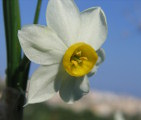 | |
| MaltaWildPlants.com by Stephen Mifsud |

|
| |
|
|
 |  |  |  |
| External Links: |
|
Antirrhinum tortuosum (Greater Snapdragon) |
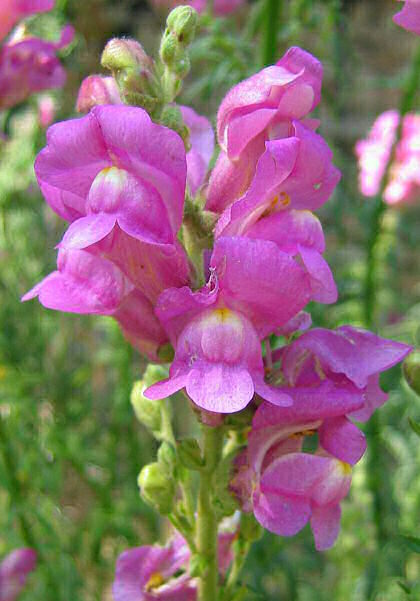
Antirrhinum tortuosum (PLANTAGINACEAE.)
Images for this profile are taken from the Maltese Islands after year 2000. |
|
| Nomenclature |
Species name : | Antirrhinum tortuosum Bosc ex Lam. | Authority : | Louis Augustin Guillaume Bosc, France, (1759 - 1828) ;
John Ball, Ireland/Morocco, (1818 - 1889) | Synonyms :
(basionym or principal syn.) |
|
Plant Family : | | English name(s) : | Greater Snapdragon, Lion's Mouth, Bunny Mouth | Maltese name(s) : | Papoċċi ħomor | Status for Malta : | Indigenous. Present on the Maltese islands before man | Name Derivation : |
Antirrhinum: from Anti- meaning front or protruding and -rhinon meaning a snout or nose, for the flower form, which has a frontal rounded snout-shaped structure. (Greek origin ); 2 = "anti" = front ; "rhinon" = snout, referring to the flower form which has a frontal snout shape (Greek);.
tortuosum: twisted, wound or abruptly bent, with reference to the leaves. (Latin origin ); 2 = winding, very twisted or bent, with reference to the leaves (Latin).
| Remarks : | |
|
| Morphology and structure |
PLANT STRUCTURE: |
Character | Growth Form | Branching | Surface |
Description | | | |
General
Picture |  |  | 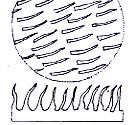 |
|
LEAVES: |
Character | Arrangement | Attachment | Venation |
Description | | | |
General
Picture |  |  |  |
| |
Character | Leaf Shape | Leaf Margin | Remarks |
Description | | | Leaf branches are twined or twisted An interesting feature of this species is that its leaves of the main stem are not straight but tend to twist, bent or even intertwine, or in one word they are tortuous. |
General
Picture |  |  |  |
|
FLOWERS: |
Character | Colour | Basic Flower Type | No. of Petals | No. of Sepals |
Description | Bright Purple | | 2 Upper and lower modified petals resting on each other and hence described as 2 lips. | 5 |
General
Picture | | 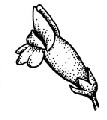 |  |  |
| |
Character | Inflorescence | Description | Ovary | Stamens |
Description | | The flower consists of 5 small oval sepals and a corolla of 2 large and complex, purple petals (lips) resting on each other and forming a closed tube. The lower lip is smaller but further decorated by a white bordered, bright yellow patch at the centre. Inside the flower, there are 4 stamens and a pistil, all close together and located at the roof of the upper lip. | | |
General
Picture |  |  | 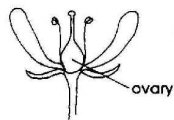 |  |
| |
Character | Scent | Average Flower Size | Pollen Colour | Other Notes |
Description | YES Strong sweet scent similar to roses. | 22mm x 25mm x 38 mm (Length x Breadth x Depth). | Bright Yellow | - |
|
SEEDS: |
Character | No. Per Fruit | Shape | Size | Colour |
Description | >200 | Irregular cylindrical to oval shape (Seed coat possess several ridges). | 1 mm | Iodine Brown |
General
Picture |  |  |  |  |
|
FRUIT AND OTHER BOTANICAL DATA: |
Character | Fruit Type | Colour of Fruit | Subterranean Parts | Other Notes |
Description | | Beige | | - |
General
Picture | 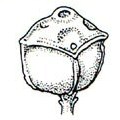 |  |  |  |
|
|
| Plant description and characters | |
Life Cycle: | Perennial. |
Growth Form: | THEROPHYTE (annual plants, herbaceous) |
Habitat: | Rock sides, rubble walls, stony rubble piles, old walls and bastions, less often in exposed karstic rock in garigue. |
Frequency: | Very Common |
Localities in Malta: | Common and spread throughout the Maltese Islands. Easily found through stony walls along the countryside. |
Plant Height: | 40-100cm. |
| Nov-Jul |
Protection in Malta: | Not legally protected till the last update of this website (2/Mar/2022) |
Red List 1989: | Not listed in the Red Data Book of the Maltese Islands |
Poison: | |
This short-lived perennial plant consists basically of erect stems of about 40-80cm in length (sometimes even up to 100cm) with simple stipuled leaf branches, and conspicuous purple inflorescence at the apex. The plant (or collective plants) tend to form many stems near each other and may look like a small shrub topped with several flowering stalks. The stem is usually woody at its base and possess short glandular hair only at the upper flowering part.
The hairless leaves, which are about 40-60mm long and 5-10mm wide, have a fusiform (spindle) shape. They have an entire outline and usually have a pale central vein. The leaves are found either on the stem as stipules (hence each supports a branch outgrowth) or on simple leaf branches, present at the middle and lower part of the main stem. They are arranged either as 3-leaf whorls or as decussate pairs. The leaf branches have an interesting characteristic of being twisted, bent or as the species name describes - tortuous.
The sweet scented flowers grows from the stem apex as short-stalked racemes. The 5mm long pedicel (stalklet) is found parallel and close to the stem and so it may be unobservable. The flower is made of 5 short, oval, hairy, overlapping sepals. a bilaterally symmetrical purple corolla, 4 stamens and a simple pistil. The corolla is a tube-like structure made up from 2 complex-structured, purple-red, lip-like petals resting on each other. The upper lip has 2 lobes, and the lower and smaller one has 3 lobes. The lower lip has its palate (bulging central portion) dipped with a small white-bordered yellow patch. The lips are fused in such a way that they can open up, namely by pollinating insects such as bees, so that they can enter the flower to reach the nectar inside and so doing, pollinate the flower.
The tube inside the flower is purple and white striped with yellow hairy brushes at the lower lip. Also there are 4 stamens, arranged in 2 pairs, one being shorter than the other by few millimeters. They are composed of bulging, yellow anthers and purple-white filaments. There is also the style+stigma, about the same length of the longer stamens which leads to the ovary deep inside the flower at the sepals region. The style and stamens are grouped close together at the roof of the upper lip.
When the flower is old, the corolla and stamens fall off, leaving the ovary and style. The latter dries off within few days. The ovary develops into a fruit which is a poricidal, dehiscent capsule which stores hundreds of tiny seeds. When mature, the fruit dries up and the seeds escape from pore-like openings in the fruit wall by movement of the long stems with the wind. The irregularly shaped cylindrical / oval seeds are just about 1mm and are dark reddish-brown in colour. They have several ridges in their seed coat.
|
|
| Information, uses and other details |
Nativity and History
Northern Africa: Algeria; Morocco; Tunisia
Western Asia: Cyprus; Israel; Syria; Turkey
Southeastern Europe: Albania; Greece [including. Crete] ; Italy [incl. Sardinia, Sicily] ; Yugoslavia
Southwestern Europe: France; Spain [incl. Baleares]
[WWW-48]
Snapdragons are old decorative flowers, which were already known to the Romans. From genetic center around southern Spain the cultivated form was spread throughout the whole Roman empire. Nowadays remnants of these original population which all belong to the species Antirrhinum majus are found among Roman remains like temples, stadia etc in southern France, Malta, Israel and so on. The scientific name of the genus Antirrhinum was first defined by Carl von Linné (also Carl Linnaeus) in the year 1753. [WWW-59]
Cultivation Details
Prefers a light well drained loam and a sunny position [1, 200] . Plants are tolerant of clay and lime soils, and also grow well on old walls [200] . Plants are often grown as an annual since they usually degenerate in their second year [1] . They often self sow when well-sited [KF] .
Edible Uses
The numerous seeds yield a fixed oil by expression which is said to be little inferior to olive oil. For this purpose it has been cultivated in Russia. [WWW-03].
Medicinal Uses
The plant has the following medicinal properties: [4, 7, 115] .
| AntiCancer |
used in the treatment of cancer; "anticancer drug"; "an antineoplastic effect". [WWW-32] |
| Antiphlogistic |
Substances which reduces or counteracts inflammation [WWW-32] |
| Bitter |
the property of having a harsh unpleasant taste [WWW-32] |
| Resolvent |
Has the ability to disperse inflammatory or other tumours; a discutient; anything which aids the absorption of effused products [WWW-32] |
| Stimulant |
Produces a temporary increase of vital activity in the organism, or in any of
its parts; [WWW-32] |
The plant has bitter and stimulant properties, and the leaves have been employed in cataplasms to tumours and ulcers. It was valued in olden times like the Toadflax as a preservative against witchcraft. The leaves and flowers are antiphlogistic, bitter, resolvent and stimulant [7, 115] . They have been employed in poultices on tumours and ulcers [4] . It is effective in the treatment of all kinds of inflammation and is also used on haemorrhoids [7] . The plant is harvested in the summer when in flower and is dried for later use [7] .
Other Uses
A green dye is obtained from the flowers, it does not require a mordant [168] . Dark green and gold can also be obtained if a mordant is used [168] . However the main general use nowadays is that of being a decorative and ornamental plant due to the numerous highly coloured and scented flowers [200]
Active Components
The following is a list of flavonoid substances detected in snapdragons (as published in Harbone J.B.) [WWW-35]
- Anthocyanidins:
+ Cyanidin 3-rutinoside
+ Pelargonidin 3-rutinoside
- Flavonols:
+ Quercetin 3-glucoside
+ Quercetin 3-rutinoside
+ Kaempferol 3-glucoside
+ Kaempferol 3,7-diglucoside
- Flavones: ( the property of having a harsh unpleasant taste)
+ Apigenin 7-glucuronide
+ Apigenin 7,4'-diglucuronide
+ Luteolin 7-glucuronide
+Chrysoeriol 7-glucuronide
- Aurones:
+ Aureusidin 6-glucoside
+ Bracteatin 6-glucoside
- Flavanones:
+ Naringenin 7-glucoside
+ Naringenin 7-rhamnosylglycoside
- Cinnamic acids:
+ p-Coumarylglucose
+ Caffeylglucose
+ Ferulylglucose
Antirrhinoside and its synthesis in A. majus
Antirrhinoside is one of the main constituents in Antirrhinum majus. It is an iridoid glucoside which is of terpenoid origin and it constitutes about 2% of the fresh weight of the plant. Iridoids are usually found in Sympetalous plant families, but antirrhinoside is only rarely found outside Scrophulariaceae / Antirrhinae. Full document by Soren Rosendal Jensen (Dept. Organic Chemistry, DTU, Lyngby, Denmark) can be seen here.
The importance of antirrhinoside is explained by Signe M. Frederiksen, PhD-student, DTU in his research project in 'special chemicals and pharmaceuticals from plants'. He states that:
" Antirrinoside was studied in terms of structural features and compared to a selection of known biologically active compounds. This study showed that antirrinoside can easily be converted into analogues of these compounds using simple chemistry. The general advantage of using an iridoid as synthon is due to the fact that products can be obtained in enantiomeric pure form without the use of any expensive chiral agents. The talk will concentrate on the following subjects:
- 1: Antirrinoside was easily converted into analogues of tecomanine, a natural product with hypoglycaemic activity.
- 2: Simple chemistry was shown to lead to a versatile intermediate in high yield. Same intermediate was recently used to prove the structure of a new isolate from Antirrhinum majus.
- 3: Ozonlysis was used as a key step to obtain pyrrolidines. Compounds with close structural similarity to known neurotransmitter antagonists is currently being prepared.
- 4: Future plans include the conversion to carbocyclic nucleosides. "
Diseases and Parasites of the plant
The plant is susceptible to varies diseases caused by viruses, parasites and microorganisms. A list of diseases compiled by Kurt stueber [WWW-59] which are commonly found in snapdragons can be seen here. A list of possible viral susceptibilities for this plant is also given by Plant Viruses Online [WWW-15] and can be seen here
Pollination
Pollination of snapdragons is done by a variety of different insects. Basically, the pollinator, usually a flying one, has to have enough weight and energy to open the pouch-like corolla and enter the flower to collect the nectar, while in the same time pollinate the flower. However, some smart insects have learnt in some way or other that biting the lower neck or tube of the flower would lead them directly to the nectar store of the flower and so they 'steal' the nectar without having to spend extra effort to open the flower mechanically. [273, WWW-59] . The list of pollinators with various pictures in action can be seen here [ WWW-59]
Personal Observations
Relationship between flower and pollinators
One interesting feature is the flower mechanism in relationship with pollinators. The corolla is made in a way that only specific pollinating insects of certain size (and hence weight) can enter inside the flower for nectar. The lip just shuts slightly open with the 'correct' weight of the pollinator. Very light insects (for example flies) are not heavy enough to make the corolla shut open. The main objective being that the flower ensure that only certain insects which dimensionally can promote pollination are allowed to enter the flower for its nectar. Other much smaller / larger insects which cannot pollinate the flower cannot enter, and so the nectar is saved. [SM]
Another more interesting fact is how certain bees have learnt to take a short cut and instead of making effort to enter the flower, they bite the lower part of the flower where the nectar is stored, and so, they 'steal' the nectar from this perforation. It is incredible that insects have this intelligence or better to call it as instinct. However not all bees have this intelligence, since otherwise one would not see any bees entering flowers in the normal and harder method - every bee would prefer to take the short cut. So probably one explanation could be that certain bees have stronger power of smell for nectar than others and so they can locate the nectar stores from outside the flower and by instinct they bite this location to find the nectar. [SM]
Toxicity of the plant
It was curious to find that many sources described the antirrhinum species as non toxic and safe while few others suggests that all parts of the plant are poisonous. Sources which state the plant to be toxic are these: example 1 example 2 . Those who clearly states 'safe' or not poisonous are these examples: example 1 example 2 example 3 and example 4 including this broucher about plants for children. It seems that generally there are more sources which classify the plant as a non-toxic one, and so it is safe to say that it is unlikely to be poisonous. [SM]
Flowers blooms white in water
During the study of this plant, 4 flowering stems were kept in a vase of water (only) . The flowers kept maturing and buds blossoming for 10 days. However there was an interesting feature:- the new blossomed flowers were getting faded from their purple colour, and eventually newer flowers opened just white with very little tinge or patches pale purple colour. {Click here to see photo} This concludes that the plant needs certain nutrients from the soil which are critical to form the purple pigment in the flower. On the other hand, the yellow pigment at the palate was present in all flowers [SM].
Hybrid possibly between A. siculum and A. tortuosum
During a walk in the countryside of the Maltese islands at the end of April, I came across a snapdragon plant which had both features of the A. siculum and A. tortuosum The colour of the flowers was white with purple patches and purple veins especially at the upper lip. This feature is similar to A. siculum, although the latter has the purple colour usually limited to the in the lobes of the upper lip only but not the tube. The flower size and shape is then definitely like the A. tortuosum, larger and more defined. The hairy calyx is also alike the A.tortuosum, overlapping and has a broad oval shape. The leaf branches were not so much twisted and bent, hence more similar to the A. siculum, but still there where some twisted leaf branches as in A. tortuosum, but in less numbers. Photos of this hybrid plant can be seen in the photogallery below (last 4 photos)
There are 2 conclusions that one can arrive to explain this plant - either this is a new Antirrhinum majus sub-species or this plant is a case of hybridization by cross fertilization between A. siculum and A. tortuosum. The latter is more plausible, but than still there is the question - If cross fertilization is possible between the two Antirrhinum species, why this plant is very rare to encounter in the wild when considering that there are so much of the 2 'parent' plants around the Maltese islands and so cross pollination is easy to take place?. [SM]
This case was reported to Dr. Struber who is an expert on this species amongst others who in turn forwarded the case to Dr.
Wolf-Ekkehard Lonnig, Senior Scientist at Max-Planck-Institut fur Zuchtungsforschung, Germany [WL]. His reply was as follows:
" Well, some years ago I crossed Antirrhinum siculum ('mothers') X Antirrhinum majus ('fathers')
From about 30,000 seeds we obtained only 28 (or 30) F1-plants with intermediate features. So most of the seeds simply did not germinate: we had some 300 pots into which we had sown the seeds, and - after a much longer than the
normal period for seed germination, single seedlings appeared in some of these pots). These F1-plants proved to be fertile producing an enormously segregating F2-population.
So crosses in wild populations might also be very rarely successful (even if pollen of one species is often transferred to the style and stigma of the other and vice versa and even if seeds are produced).
This could explain your case. The best would be to take the seeds of the plant you describe and look at the putative F2 population. But, of course, this one plant might already be an F2 individual/descendent of such a F1 plant, so that segregation could be reduced. " [WL].
Hence this hybrid plant may be a case of a rare (30 : 30,000) natural occasion of hybridization between A. siculum and A. majus spp tortuousum. After several discussions I and Dr. Lonning arranged that I send him some seeds to his Laboratories in Germany, and he will sow and study the hybrid plant that I found in Malta. Results to follow in few months time. [SM]
|
|
| Links & Further literature
(0 papers) |

Google Web |

Google Images |

Google Scholar |

Research Gate |

Wikipedia |

JSTOR |

GBIF |

Med Checklist |

Cat. of Life |

EoL |

IPNI |

World Flora Online |

Plants of the World Online |

Vienna Virt. Herb. |

RBGE Herbarium |

KEW Herbarium |

MNHN |

Arkive |

IUCN |

CABI |
Kindly Email if there are papers and publications about local
studies or information about this species to be included in the list above.
|
| Photo Gallery (37 Images) | 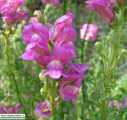 |
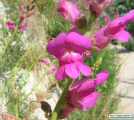 |
 |
 |
IMAGE: ARRTO-01 Photo of flowers in situ. |
IMAGE: ARRTO-02 Photo of flowers which are bilaterally symmetrical (zygomorphic). |
IMAGE: ARRTO-03 Photo of 2 flowers which have a bright purple colour with a white to yellow tipped mouth. This part of the flower is referred to as the palate. |
IMAGE: ARRTO-04 Close up photo of flower. It consists of an upper lip with 2 large 'lobes' and a lower lip with 3 smaller lobes. |
 |
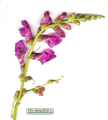 |
 |
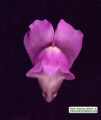 |
IMAGE: ARRTO-05 Photo of flower raceme in situ. Each raceme may have up to 10 blossomed flowers. |
IMAGE: ARRTO-06 Scanned image of flowering stem including young buds. |
IMAGE: ARRTO-07 Scanned image of flowering stem against a dark background. It can be noted that the stem, flower and calyx are covered with fine hair. |
IMAGE: ARRTO-08 Large scanned image of single flower - Front view. |
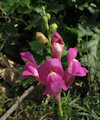 |
 |
 |
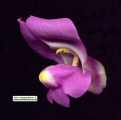 |
IMAGE: ARRTO-09 Photo of another specimen of Antirrhinum tortuosum in the wild. |
IMAGE: ARRTO-10 Photo comparing the white form next to the normal purple form. |
IMAGE: ARRTO-11 Photo of a specimen having white flowers. There is a hint of purple at the base of the flower so it is not a complete albinism. This specimen was one from about 100 specimens found in a agricultural area and it is thought that there is a link between this colour form and application of herbicide or other chemical application. |
IMAGE: ARRTO-12 Large scanned image of flower, held open by a piece of match stick inside. Pollinating bees will open the two lips and enter the flower to reach the nectar. Doing so they will usually rub their thorax with the stamens and stigma positioned below the upper lip. |
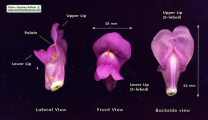 |
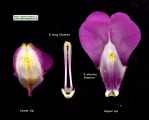 |
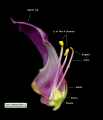 |
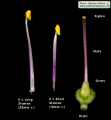 |
IMAGE: ARRTO-13 Scanned image of dissected flower to reveal its anatomy as annotated on the image itself. |
IMAGE: ARRTO-14 Scanned image of lower lip, upper lip and stamens. There are 4 stamens, 2 being longer by few millimeters. |
IMAGE: ARRTO-15 Scanned image of a laterally dissected flower showing arrangement of stamen and pistil. Lower lip petal has been removed. |
IMAGE: ARRTO-16 Magnified scanned image of 2 stamens and pistil. Stamens consist of a purple filament and swollen yellow anthers. |
 |
 |
 |
 |
IMAGE: ARRTO-17 Scanned image of lower leaves. Lanceolate to spindle shape (fusiform), hairless and about 6cm long. |
IMAGE: ARRTO-18 Scanned image of lower leaves. More slender and smaller (5cm long) and also darker in colour. |
IMAGE: ARRTO-19 Scanned image of branch of leaves to show the twining and twisting characteristic (pointed by the arrow), hence the species name 'tortuosum' (twisted, bent). |
IMAGE: ARRTO-20 Scanned image of stem and leaf branches showing the twisting and bending of the leaf branches. |
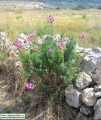 |
 |
 |
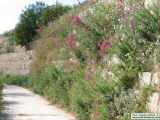 |
IMAGE: ARRTO-21 Photo of plant in situ - Common place to find this plant is through walls, especially the traditional Maltese farmer walls (hajt tas-sejjieh). |
IMAGE: ARRTO-22 Photo of plant in situ - It consists of numerous long shooting stems (up to 80cm) topped with their purple flowers. |
IMAGE: ARRTO-23 Photo of plant in situ - Stems could be so close together and densely packed that the plant may take the appearance of a bush. |
IMAGE: ARRTO-24 Photo of plant in situ - A typical example of the preferred habitat of the plant, hence through cracks and gaps in walls.Photo taken at Chadwik lakes. |
 |
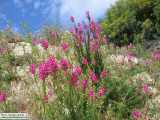 |
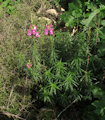 |
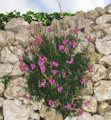 |
IMAGE: ARRTO-25 Photo of plant in situ - small plant in a pit of soil in a rock. |
IMAGE: ARRTO-26 Photo of plant in situ - colourful and attractive blooms and its sweet scent attracts many bees. |
IMAGE: ARRTO-27 Photo of a plant with linear leaves and spikes of purple flowers. |
IMAGE: ARRTO-28 Photo of a beutiful specimen growing and hanging down from a wall. |
 |
 |
 |
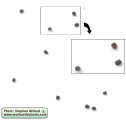 |
IMAGE: ARRTO-29 Scanned image of a very young fruit enclosed in a calyx made up of 5 overlapping, hairy sepals. The corolla and stamens fall off but the stigma+style remains attached with the ovary for some time. |
IMAGE: ARRTO-30 |
IMAGE: ARRTO-31 Scanned image of dry fruit. The tiny seeds escape from the 3 holes in the fruit by shaking of the stems with wind. The shape and colour of the fruit resembles an old skull of some animal. |
IMAGE: ARRTO-32 Scanned image of tiny seeds (about 1 mm in size). |
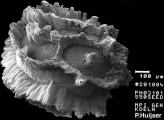 |
 |
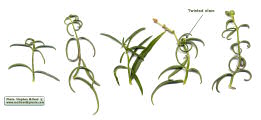 |
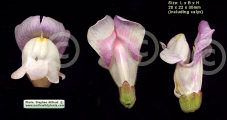 |
IMAGE: ARRTO-33 Magnified scanned image of one seed under electron microscope (photo by P. Huijser from [WWW-59] ). |
IMAGE: ARRTO-34 Scanned image of a plant which looks too be a hybrid between the Antirrhinum tortuosum and A. siculum since it has features from both (sub-)species. White flowers like A. siculum but large and more purple colour like A. tortuosum. It could also be a mutation / defect in the colour synthesis of the plant. |
IMAGE: ARRTO-35 Scanned image of several leaf branches of the Hybrid A. tortuosum plant. Many branches are like the A. siculum hence not twisted or bent, however some twisted branhces can still be found in the plant. It could also be a mutation / defect in the colour synthesis of the plant. |
IMAGE: ARRTO-36 Scanned image of the the A. tortuosum hybrid flowers from front, lateral and back view. The dimensions and size of the flowers are similar to the A. tortuosum but the white colour with purple veined lips are characteristic of the A. siculum It could also be a mutation / defect in the colour synthesis of the plant. |
 |
| | | IMAGE: ARRTO-37 Scanned image of the anatomy inside the Hybrid flower. The size and shape is more similar to the tortuosum, but lacks the purple pigment both in the lips and the anthers' filaments. The calyx is also alike the A. tortuosum species. It could also be a mutation / defect in the colour synthesis of the plant. |
IMAGE: ARRTO-38 |
IMAGE: ARRTO-39 |
IMAGE: ARRTO-40 |
|
| | |

